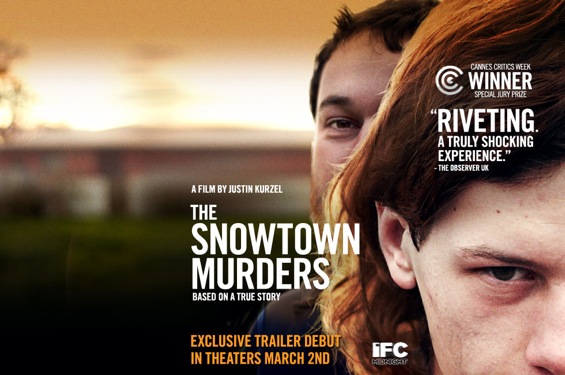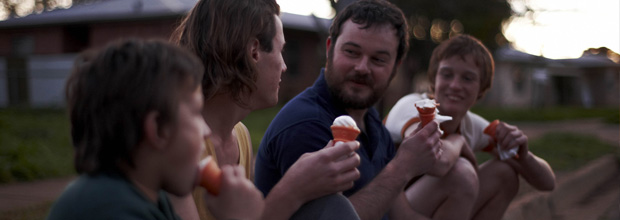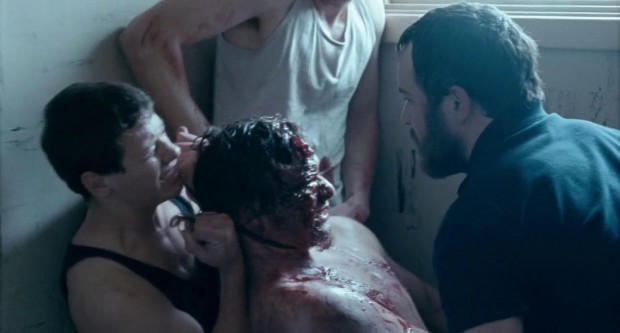Was that a real kangaroo? I kept wondering that as John Bunting (Daniel Henshall) hacks off the paws and head of the dead creature as his girlfriend’s 16-year-old son Jamie Vlassakis (Lucas Pittaway) looks on. He will join John in dumping the bloody, butchered remains on the front porch of a known pedophile. Later, John watches smugly as the man moves away.
Director Justin Kurzel’s debut feature The Snowtown Murders (winner of the 2011 Cannes Film Festival Jury Prize) observes the grim lives of these Australians, who live in what can only politely be called a slum. Based on true events, Snowtown’s minimalist, no-frills, “documentary”-style approach perfectly captures their nowhere lives and inevitable tragedy as Jamie and his family join Bunting in his self-styled neighborhood watch endeavors; what follows is a series of vicious murders punctuated by horrific torture.
The film is based on events which occurred in the state of South Australia, Australia, in the area of Adelaide between 1992 and 1999. Eleven bodies were discovered stuffed into barrels in an abandoned bank in the small town of Snowtown, the culmination of a five-year investigation into Bunting, who is now known as Australia’s worst serial killer. These facts appear as title cards after the ending, in the now-obligatory addition to nearly all true-life stories. This is the only thing The Snowtown Murders really shares with some of its most recent cousins, such as David Fincher‘s Zodiac. You’d have to go clear back to In Cold Blood to find such an inside-out treatment of this kind of story.
Written by Shaun Grant and based on the books Killing for Pleasure by Debi Marshall and The Snowtown Murders by Andrew McGarry, Kurzel’s film spends times simply regarding Vlassakis and his family: Jamie has a couple of half-brothers and his mother Elizabeth (Louise Harris) looks and acts sickly and seems marginally employed, if at all. Their existence consists of TV, church groups, riding bikes, and being photographed in various states of undress by a neighbor. Kurzel and cinematographer Adam Arkapaw (Animal Kingdom), regard the implied sexual abuse with the same dispassion these people seem to feel about themselves and each other. There are few close-ups, and some of the more disturbing parts – like a graphic torture scene or an instance of incestuous homosexual rape – occur in medium and long shots.
Things change when John Bunting arrives. Relatively charming and gregarious, with a hard, flinty look in his eye, Bunting quickly ingratiates himself with the community. He rails against the perceived scum surrounding the neighborhood: shouting “fags,” junkies, pedophiles, all while his usually-silent friend looks on. We slowly come to realize that Bunting’s demented ranting is a way to justify – however flimsily – his simple desire to kill, and he’s been doing it for quite awhile by the time the audience meets him.
The triumph of The Snowtown Murders is how deep we go into Jamie’s mind. Many of the details about the real person remain suppressed by the Australian government. Newcomer Pittaway has no process – Jamie is a wounded loss of a person, and once he’s accepted by Bunting’s magnetic, (clinically-diagnosed) psychopathic personality, he finds the father figure his life is missing.
If the police are investigating them – and they actually had listening devices installed in their acquaintances’ houses as early as 1994 – the killers and the audience are oblivious. We stay firmly inside the inner circle, and are as emotionally drained and mentally wrought by the end as Jamie, who is currently up for parole consideration in 26 years. It’s a harrowing, hypnotic and unshakable experience.
The Snowtown Murders (or, Snowtown) is now available on demand and hits theaters March 2nd.



